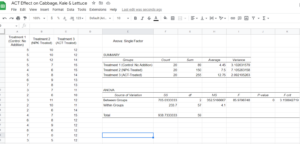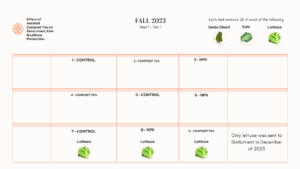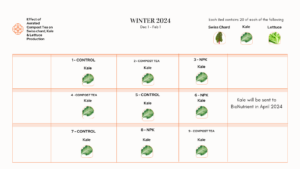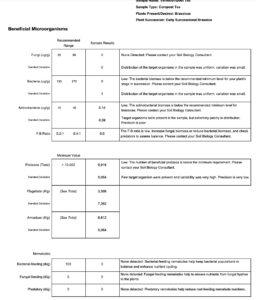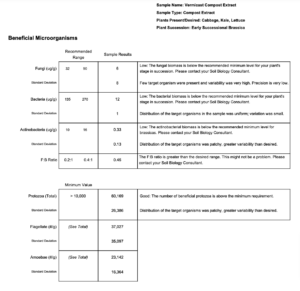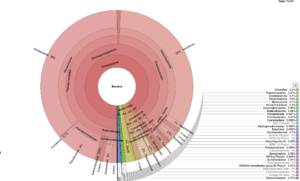Progress report for FS23-353
Project Information
Abstract
Solutions to the problem of high-cost, unsafe, and non-sustainable commercial fertilizers will involve finding fertility methodologies that are:
- As effective as their commercial counterparts (if not more so)
- Low-cost - Solutions with minimal or preferably a one-time investment that is not reliant on industrial systems
- Sustainable - Solutions used to increase soil fertility and crop yield incrementally over time with repeated usage. A solution that "builds soil" with residual effects that are beneficial and not harmful to the environment.
A possible solution to the problem of commercial fertilizers could be using Aerated Compost Tea (ACT) during the growing phase of crops.
This study observes and measures the effects of ACT on the:
- Germination
- Growth
- Weight
- Crown diameter
- Yield
- Nutrient Density
Of Swiss Chard (Beta vulgaris L. var. cicla), Lettuce (Lactuca sativa), and Kale (Brassica oleracea var. sabellica) in a 3-month growing season.
What is Aerated Compost Tea (ACT)?
Aerated compost tea is the cultivation of the diversity and biomass of beneficial aerobic microorganisms in the soil through the suspension of compost in an aerated water solution which includes trace amounts of bacterial food in the form of molasses and fish emulsion (Morgan, 2017).
The finished solution, shown to have the highest microbial population on Day 3 after aeration, is applied to the soil where crops are grown on Day 2, before the microbial peak, to promote soil fertility and improve crop growth (Kim et al., 2015).
What are the Benefits of Aerated Compost Tea if Proven a Viable Solution?
If ACT is proven to be viable, its benefits would be the following:
-
Lowered Costs for External Inputs in the Current System of Farming
Current costs for farmer fertilizer inputs have risen dramatically this year.
"Several phosphate and potash fertilizer products have increased by 15-20 percent since late September, while the cost of anhydrous ammonia, urea, and other nitrogen fertilizer products have increased by approximately 50 percent in the past two months. The rapid increase in fertilizer costs is being driven by high global demand, very tight supplies of many fertilizer ingredients, and by shipping issues at U.S. ports"(Thiesse, 2022).
Unlike expensive chemical fertilizers, ACT requires no huge expense apart from the purchase of the following one-time equipment:
- A 5-gallon bucket
- A 200-watt pump and hose
- A mesh from which to suspend compost
- vermicomposting worms for the creation of bacterially-rich compost or a plant-based thermophilic compost
Thus ACT is not industry-dependent since the farmer can create compost tea on the farm from his or her production waste.
Neither does ACT require a lot of input in time. The ACT process can take as little as 10 minutes to set up as long as a source of compost is readily available.
In this study, pathogen-free vermicompost and hot/thermophilic compost will serve as the source of compost. This compost is created in situ and does not require external purchase or inputs aside from the optional purchase of red wriggler composting worms (Eisenia foetida).
-
Similar or Improved Soil and Crop Fertility
ACT has been used as a crop fertilizer, soil amendment, disease-suppressant, and foliar spray (Shaban & Fazeli-Nasab, 2015), playing a possible three-fold agricultural role in food production and negating the need for additional soil amendment or foliar spray products.
In the soil, it introduces higher concentrations of microbial populations to increase their diversity and number. An increase in beneficial microbial life in the soil correlates with an increase in soil fertility (Ingham, 2005).
This microbial life, in turn, increases water retention and improves soil tilth or structure.
The liquid nature of compost tea allows it to seep into the soil and "harder-to-reach" areas without much effort on the part of the farmer.
If proven viable, ACT could yield similar or better crop fertility, growth, and yield. This would mean better or comparable results without the detrimental effects of chemicals in our soils and food.
-
Increased Nutrient-Density in Crop Production
If proven viable, another benefit of using ACT in crop production would be an increase in the nutrient density of the crops we grow.
Nutrient density means a higher level of nutrition for the customers and community without the ill effects of residual chemicals in food.
What are the Benefits of Studying ACT's Effects on Swiss Chard, Kale, and Lettuce?
Swiss chard (Beta vulgaris L. var. cicla), kale (Brassica oleracea var. sabellica), & lettuce (Lactuca sativa) have a longer growing season than just the three summer months of June-August in the temperate climates of Virginia.
As such, they provide a more extended harvest season and longer-term potential income for the farmer throughout the year.
Another reason to study compost tea in the growth of these vegetables is that there are not many studies on the effects of compost tea on foliation. Instead, most studies deal with disease suppression. It would be good for farmers to understand the specific uses compost tea applications hold for different vegetables and at different seasons of the year. This study on leafy greens sheds light on one type of vegetable that is underrepresented in the literature.
Proposed Solution
I propose a study measuring the growth, yield, and nutrient density of Swiss Chard (Beta vulgaris L. var. cicla), kale (Brassica oleracea var. sabellica), & lettuce (Lactuca sativa) grown with and without ACT to discover whether or not ACT could outperform or match the results found by the use commercial fertilizers.
The benefits of such a solution would be:
- Lowered Costs for External Inputs in the Current System of Farming
- Similar or Improved Soil and Crop Fertility
- Increased Nutrient Density in Crop Production
Research Question and Objective
In this study, I will measure the effects of weekly Aerated Compost Tea (ACT) soil application on the production yield of Swiss chard (Beta vulgaris L. var. cicla), kale (Brassica oleracea var. sabellica), & lettuce (Lactuca sativa)
Research Hypothesis
I hypothesize that a weekly application of ACT to Swiss chard, kale, and lettuce will result in the same or improved yields as those to which commercial fertilizers (Nitrogen, Phosphate, and Potassium) are applied.
A secondary hypothesis is that a weekly application of ACT will result in greater nutrient density in Swiss chard, kale, and lettuce compared to those to which commercial fertilizers (NPK) are applied.
Cooperators
- - Producer (Educator and Researcher)
- - Producer
Research
Data Collection & Measurements
Measuring Crop Yield in Pounds
Using Single-Factor ANOVA (Analysis of Variance) tests, I will measure yield in terms of harvested crops' weight (in pounds) at the end of 100 days for Napa cabbage, 60 days for kale, and 31 days for lettuce.
Here is a sample image of how I would use ANOVA and plot my findings of yield in pounds. Please note: This is hypothetical data. I have yet to conduct this research.
Measuring Nutrient-Density in Crops
With the help of the Bionutrient Food Association (BFA), I will send samples of Swiss chard, kale, and lettuce to the BFA labs for nutrient-dense analysis within a day after harvest.
Bionutrient Food Association has the largest nutrition database in crops of its kind.
How Crop Testing Works
Growing partners submit food and soil samples to the Bionutrient Institute Lab and share information about how those crops were managed using the BI SurveyStack App. This app walks the user through detailed instructions on collecting food and soil samples and how to package samples for shipping. After the lab receives and processes samples, it returns a detailed report on crop and soil nutrition, comparing it against a spectrum of crops in its database.
Location and Choice and Map Plotting
The location I have chosen is the space below to be used for (9) nine 6 x 4 beds in our production garden on our farm, Bethany Farms, 41558 Stumptown Rd., Leesburg, VA 20176.
- Each bed is planted with 20 seeds of Swiss chard, lettuce, and kale. Each crop is numbered one to twenty.
Fall 2023 (Sept 1 - Dec 1)
Winter 2023-2024 (January 13 - March 1)
Project Implementation
This grant started on April 1, 2023, Swiss chard, kale, and lettuce, were grown starting in October after research beds were built and compost and compost tea were tested in labs.
The first harvest of lettuce was on December 1st, 2023 and was sent to BioNutrient for analysis.
The total harvest, measurement, and weight of the first batch of lettuce planted in October 2023 was on March 1st, 2024.
Brewing the Aerated Compost Tea
Aerated Compost Tea (ACT) will be brewed using the guidelines outlined in this SARE Document, "Aerated Compost Tea: A Field Guide
to Production Methods, Formulas, and Application Protocols," keeping in mind the need to create a pathogen-free ACT with every application. This manual emphasizes that compost from which ACT is made cannot contain animal products and must be free of four types of pathogens:
- Salmonella
- E.coli
- Listeria monocytogenes and
- Fecal coliforms
This SARE document on ACT also recommended labs that can test compost for the presence of these pathogens before making compost tea from them.
As part of this study, a sample of finished vermicompost and thermophilic compost would be sent each season to one of the labs mentioned in the document before brewing ACT. This would ensure the pathogen-free nature of the ACT used in the test. I also plan to do a direct microscopic count of microbiology in 1-hr old ACT.
Preparation for Crop Testing
- Creation of Viable ACT
Creation of finished vermicompost and thermophilic compost. If found pathogen-free, ACT will be brewed from an equal mixture of both composts. Previous studies on ACT have shown that diversity in compost types produces more effective compost teas (Kim et al., 2015). ACT will be applied to the soil-growing media of Swiss chard, kale, and lettuce seeds sown on October 31 (See timeline in this document). - Soil Testing to determine N-application requirements
- Using the Southeastern Vegetable Crop Handbook, and soil test results, the amount of the recommended Nitrogen application for leafy greens was determined. This application was 1/4 teaspoon of this commercial Nitrogen product per 5 gallons.
- Building the Raised Beds
Growing & Testing Phases
Crop Trial 1: Fall 2023 (Oct 31 - Dec 8)
Crop Trial 2:Winter 2023-2024 (January 13 - March 1)
Crop Trial 3: Spring 2024 (April 1-July 24)
Data Analysis, Study, and Outreach Phase
Winter 2024-2025 (November 13 - March 31)
I plan to present my findings at the VA Biological Conference in January 2025 and.
Observation and Data Recording
Before harvest, I plan to note any observations of the above-ground growth of Swiss chard, kale, and lettuce. These observations would include, but are not limited to:
- Checking for the presence of
- Weeds
- Pests
- Disease
- Measuring the "diameter crown" width of cabbage, kale, and lettuce
Records on this Google Sheets document.
Photos in this Google Drive Folder.
Documents in this Google Drive Folder.
Data Analysis
After consultation with Shawn Jadrinicek, a practicing permaculturist, author, and Virginia Tech extension agent about the data, I will report on the viability of ACT as an alternative means of fertilization to commercial fertilizers.
Treatments: I will conduct this experiment using three treatments:
- Treatment 1: Control - Untreated raised bed of 20 Swiss chard, 20 kale plants, and 20 lettuce plants
- Treatment 2: NPK-Treated crops - a raised bed of 20 Swiss chard, 20 kale plants, and 20 lettuce plants that are treated with Southern Ag NPK (10-10-10) All-Purpose Granular Fertilizer (1 cup per 25-foot row / monthly)
- Treatment 3: ACT-Treated crops - a raised bed of 20 Swiss chard, 20 kale plants, and 20 lettuce plants treated with ACT every week.
Variable: Crop Yield
Results and discussion
What results did you achieve and how were they measured? For production projects, include yields, field analysis, and related data. How do these compare with conventional systems used previously?
Pre-Growing Results
Before I even grew the leafy greens I decided to test the quality of my soil, my vermicompost, and a batch of ACT made from the vermicompost bin.
Soil Test Results
I needed to test my soil to determine the required supplementation recommendations given to commercial growers and use that as my commercially-treated group.
If found that the pH could be adjusted in all the plots the same way prior to planting but the conventional fertilizer treatment should be fertilized according to industry standards.
These can be found in the Southeastern Vegetable Crop Handbook.
For growing lettuce that would mean I needed to apply 75-150lbs of N/acre and the phosphorous and potassium would vary based on soil test results.
For napa cabbage, it would be 100-175 lbs N/acre with variable amounts of P and K based on soil test.
Based on the soil tests, I only needed to supplement by way of Nitrogen.
I opted to use the N product called, “RAW Nitrogen” with 20% Ammoniacal nitrogen derived from Ammonium Sulfate. A ½ teaspoon per 5-gallon application following packet instructions was used in the first year of this experiment.
I should have checked this against the applications recommended by the Southeastern Vegetable Crop Handbook but as I was still learning how to transpose unit measurements, I thought it best to go by the manufacturer’s instructions instead.
Since then I have learned that to calculate the amount of 20% RAW Nitrogen product recommended for my lettuce beds based on the recommendation of 75-150 lbs of Nitrogen per acre, I determined the correct amount of Nitrogen needed for the area of your beds in square feet I then calculated how much of the 20% RAW Nitrogen product was required to meet that need.
- Convert the recommendation to a per-square-foot basis: There are 43,560 square feet in an acre
- Calculate the total Nitrogen needed for the beds: With three beds each being 24 square feet, I determined the total Nitrogen needed based on the lower and upper bounds of the recommendation.
- Determined the amount of 20% RAW Nitrogen product needed: Knowing that the product is 20% Nitrogen, I could calculate how much product is required to provide the necessary amount of Nitrogen.
Based on the recommendations for growing lettuce of 75-150 lbs of Nitrogen per acre:
- The Nitrogen application rate translates to approximately 0.0017 to 0.0034 lbs of Nitrogen per square foot.
- For three 24-square-foot beds (totaling 72 square feet), I would need between 0.124 and 0.248 lbs of Nitrogen to cover the low and high ends of the recommendation, respectively.
- To meet this requirement using a 20% RAW Nitrogen product, I would need to apply between 0.62 and 1.24 lbs of the product across all beds.
This means for the lettuce beds, I should apply between approximately 0.62 lbs (about 9.9 ounces) and 1.24 lbs (about 19.8 ounces) of the 20% RAW Nitrogen product to stay within the recommended Nitrogen application rates for optimal growth.
This amount should then be weighed out based on plant size and evenly broadcast by mixing the Nitrogen with water.
For the first year of growing, I followed the packet directions and only applied ½ teaspoon of nitrogen per 5-gallon application to 3 beds.
In the second growing year of this research, I will be applying 1.25 cups of Nitrogen mixed into a 5-gallon application. This is the lower end of the spectrum of recommended applications.
Microbiological Analysis
Before and during the application of ACT and Nitrogen to three of the nine beds built for the sole purpose of this research, I sent my vermicompost, and compost tea to two labs
The first lab, Brightside Acres run by Steven Disla in North Carolina came back to me in June 2023, with the results of the different bacteria analyzed and counted microscopically.
Here are the results:
Vermicompost - The recommended amount of beneficial bacteria was low and no pathogenic bacteria was present.
Vermicompost Tea - The beneficial bacteria that was present died and there was no presence of pathogenic bacteria.
Results_2023-06-27_Nicky_Schauder_Vermicompost_Extract
NickySchauder_Compost Tea_2023-11-16
When I asked the lab technician why my bacteria count was so low, he said that it was likely because I did not feed the compost tea any microbial food. So they naturally died despite being aerated.
It is because of this evidence that I question the utility of the current National Organic Standards on requiring no additives or feed be given to microbes in the creation of agricultural teas.
I think the regulations should be such that it is not advisable to make compost tea from large and medium animal fecal material, but should be allowed to brew from verimcomposting worms because there are at least two studies that show a reduction in pathogens when passed through the gut of Eisenia fetida and Eisenia andrei. Both these species are vermicomposting worms.
According to Procházková et al. (2018), the introduction of Eisenia andrei earthworms significantly contributes to the reduction of pathogen levels in vermicomposting processes.
Eastman et al. (2001) explored the effectiveness of vermiculture in reducing human pathogens in USEPA biosolids stabilization, indicating a significant potential for sustainable waste management.
I will be sending another vermicompost and compost extract sample for testing in 2024 to build upon this knowledge and verify whether my vermicompost culture has improved. These samples of vermicompost were sent at the early stages of creating the vermicompost bin. One year later, the worm bin is more robust and stable.
Here are the results of the microbiome analysis of vermicompost and compost tea that was brewed with additives of humic acid and seaweed. No molasses was used by the recommendations of Elaine Ingham in her Compost Tea Brewing manual (Ingham, 2002).
Vermitea Report
These reports were very interesting because they showed a significant drop in diversity of bacteria from the vermicompost to after the tea was brewed.
The bacterial populations that did survive were exponentially amplified as shown in these Krona graph examples
In this first Krona graph you will notice a diversity in the types of bacteria present due to the varying colors represented in the graph
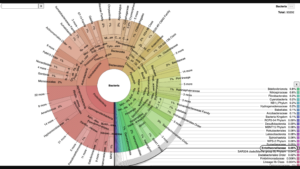
In the second you see how the diversity is much less, but the bacteria that do survive are amplified.
This means that the aeration of the compost extraction results in the death of the majority of the bacterial players but those that survive increase their population. The next question from this phenomenon would be, what do these bacteria do for the plants and why would they be helpful for plant growth?
Educational & Outreach Activities
Participation Summary:
Outreach is the heart of the work that I do on my farm. Each growing act, for me, is an act of service and outreach. The food that I grow and sell is an outreach.
I teach how to grow food online monthly in a live workshop, sometimes daily through social media, and weekly through my gardening newsletter. This is how I currently teach families how to grow their own food and medicine and find God through ecological gardening.
I have a mailing list of about 3,000 people around the US and abroad, and I teach on webinars, conferences, and in-person.
Since 2017, I have started permaculture school gardens in Title 1 schools at the elementary and middle school level, and I continue volunteering after-school to teach gardening to middle school children in Sterling, VA, on Tuesdays.
If I can carry out this research, I plan to speak about the findings of this research at the following venues:
Monthly in 2023 - Each month, I host a "Monthly Garden Planning Workshop" online where my husband and I teach permaculture gardening for free.
Not-Confirmed Conferences:
The expenses for these conferences would be paid by Mother Earth News and not by the funding from this grant. I still include it below, as I plan to use these platforms to speak about soil health and aerated compost teas.
Mother Earth News Conferences:
February 18-19, 2023 - Belton, Texas
April 29-30, 2023 - Lawrence, Kansas
July 15-16, 2023 - Erie, Pennsylvania
Sept. 16-17, 2023 - West Bend, Wisconsin
Mother Earth News Online Conference
January 2025 - I hope to present on "The Truth About Aerated Compost Teas," at the VA Biological Farming Conference.
I hope to partner with SARE and VA Tech to teach farmers in person about what I learn from my research.
To this end, I would like to propose five visits to rural VA locations in the fall-winter of 2024-2025 where I could teach farmers about my findings on Aerated Compost Teas.
Currently, I have spoken about my Compost Tea research on podcasts such as:
GardeNerd
Lady Farmer's the Good Dirt Podcast.
I also look forward to presenting the findings of this project at local farming conferences, farming outreaches in Southern regions, and online.
Learning Outcomes
Knowledge about the safe preparation of Compost Tea
Knowledge about the appropriate use of compost tea
Knowledge about the kinds of compost tea
Knowlege about the benefits of compost tea
Project Outcomes
The project focusing on the use of Aerated Compost Tea (ACT) represents a significant stride towards enhancing agricultural sustainability. By investigating the effectiveness of ACT in improving soil fertility and crop yield, this research aligns with the broader goals of sustainable agriculture, which aims to be economically viable, environmentally friendly, and socially responsible. Here's an assessment of how the project affects agricultural sustainability or will contribute to future sustainability:
Economic Benefits
- Cost Reduction: The use of ACT offers a notable reduction in the cost of fertilizers for farmers. Given the sharp rise in commercial fertilizer prices, ACT provides a cost-effective alternative that relies on on-farm inputs rather than purchased chemical fertilizers. The initial investment in equipment for ACT production is relatively low and is a one-time cost, which could significantly lower the operational costs of farming in the long term.
- Increased Profitability: By potentially improving yield and crop quality through enhanced nutrient density, ACT could lead to higher market values for the produce and increased profitability for farmers. Additionally, the reduced cost of inputs directly translates to better financial margins.
- Resilience to Price Fluctuations: By decreasing dependence on commercial fertilizers, farmers can become more resilient to market volatility and the fluctuating prices of chemical inputs, leading to more stable economic conditions for their farming operations.
Environmental Benefits
- Soil Health Improvement: ACT enriches the soil with beneficial microbes, improving soil structure, enhancing nutrient cycling, and increasing water retention. This contributes to the long-term fertility of the soil, ensuring sustainable crop production.
- Reduction in Chemical Use: The project promotes a reduction in the use of synthetic fertilizers and pesticides, minimizing soil and water pollution. This shift contributes to the preservation of ecosystems and biodiversity within agricultural landscapes.
- Climate Change Mitigation: By enhancing soil organic matter through the application of ACT, the project contributes to carbon sequestration, helping mitigate climate change. Additionally, reducing the dependency on chemical fertilizers decreases the carbon footprint associated with their production and transportation.
Social Benefits
- Health and Safety: Reducing chemical use in agriculture diminishes farmers' and consumers' exposure to potentially harmful substances, contributing to overall public health. The production of more nutrient-dense food through ACT can also support better nutrition for communities.
- Knowledge and Skill Development: This project fosters a deeper understanding of sustainable farming practices among farmers, enhancing their skills in producing and applying ACT. It encourages knowledge-sharing within the farming community, promoting a collective move towards more sustainable agricultural practices.
- Community and Consumer Trust: By adopting environmentally friendly practices like ACT, farmers can strengthen trust with consumers who are increasingly concerned about sustainable and responsible farming methods. This can enhance community support for local agriculture and encourage a shift towards consuming locally produced, sustainable food.
Contribution to Future Sustainability
The project lays the groundwork for future research and adoption of sustainable practices in agriculture by providing empirical evidence of ACT's benefits. It serves as a model for integrating low-cost, effective, and environmentally sustainable practices into farming, encouraging wider adoption and adaptation. The findings could influence policy, encourage support for sustainable farming initiatives, and drive innovation in sustainable agriculture technologies and methodologies.
In summary, the project's focus on Aerated Compost Tea (ACT) presents a comprehensive approach to agricultural sustainability, addressing economic viability, environmental health, and social well-being. Its success could herald a significant shift towards more sustainable, resilient, and productive farming systems.
